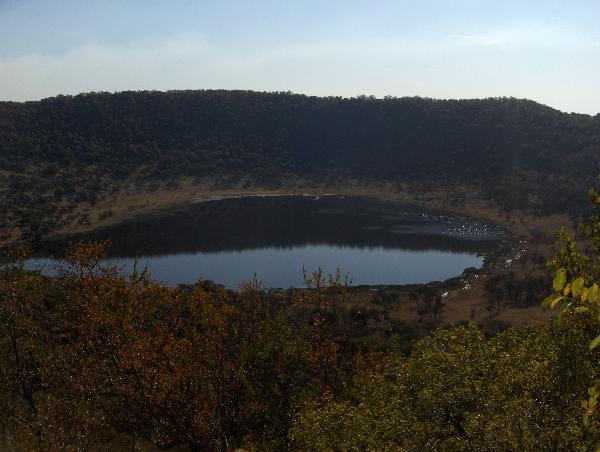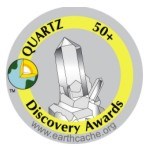What is Tswaing?
Tswaing, meaning Place of Salt in Setswana, is a 2000-hectare heritage site, some 40 km north-west of Central Pretoria, surrounded by settlements inhabited by more than a million people, such as Winterveld, Soshanguve, Mabopane and Nuwe Eersterus. It falls within the Gauteng Province, borders on North-West Province and is part of the City of Tshwane Metropolitan Municipality.
The main features of Tswaing are a 220 000-year old meteorite impact crater (100 m deep and 1,3 km across), a wetland (marsh) area, a variety of ecosystems and the remains of a factory that produced soda ash and salt.
In geological terms, the Tswaing Crater represents one of the youngest and best-preserved small bowl-shaped meteorite impact craters in the world. It used to be known as the Pretoria Saltpan.
Tswaing is a sensitive and unique conservation area for the careful and sustainable management of its multiple cultural and natural heritage resources in the disciplines of geology, the environmental sciences, biology and human history. Strong emphasis is placed on the protection and use of the area’s natural and cultural heritage for research, environmental education, recreation and community empowerment. This is achieved in close consultation with local communities, scientists, conservation agencies, private sector business and national, provincial and metropolitan government institutions.


Drilling the Crater
Drills have been put down into the crater by geologists trying to establish whether the crater was formed by a volcanic eruption or a meteorite, a controversy that has raged for some years. Because volcanic rock was found in the crater rim, it was thought for many years that Tswaing was the result of some kind of volcanic event.
In 1989 a drill was sent down 200 metres through the crater fill (sediment filling the crater over the years). Analysis of the drill core confirmed that the crater was indeed caused by a meteorite.
What was also revealed was the climatic conditions going back 200 000 years. Unlike the present climate of sub-tropical and dry-humid conditions, in the past there were alternating dry and wet periods, and at one point the site was a forest of yellowwood trees. The drill core also helped scientists determine the age of the Crater, at 220 000 years.
These drill sites now contribute to the water flow into the lake, and are still visible in the form of pipes protruding from the lake.
This analysis revealed too that several animals that lived at the time of the impact no longer exist. These include the giant wildebeest or hartebeest, a long-horned giant buffalo and a giant zebra. An early form of homo sapiens roamed the area, but would not have recorded their presence through rock art - the first rock art was recorded in South Africa 170 000 years later.
How big was the bang?
The explosion that occurs on impact is caused by the rapid release of the kinetic energy (energy due to its motion) of the object as it comes to a stop in about one hundredth of a second. The impact speed of an object falling from rest in space onto the Earth is 40 000 kilometres per hour. Incoming objects would not have been at rest and typically impact with a speed of around 60 000 kilometres per hour, ie around 16 kilometres per second.
The kinetic energy released when an object travelling at this speed is brought to rest in the impact is 100 million Joules per kilogram of mass. This is 25 times greater than the energy produced by the detonation of the same mass of high explosive such as TNT.
It has been calculated that the energy required to produce the Barringer crater was equivalent to the explosion of 15 million tonnes of TNT. As the Tswaing crater is slightly smaller than the Barringer crater, we shall assume that the energy of the explosion there was equivalent to 10 million tonnes of TNT. This happens to match the energy calculated to have been released in the Tunguska airburst event in Siberia in 1908.
The Tswaing impact energy release also matches the power of the first US hydrogen (fusion) bomb, codenamed "Mike", exploded at Eniwetok on 31 October 1952. It is one third the power of the largest Soviet test bomb, which had a yield of 58 Megatons, and was dropped on Novaya Zemla on 31 October 1961. However, 10 Megatons is 500 times the power of the 20 kiloton atomic (fission) bomb that devastated Hiroshima on 6 August 1945, killing about 150 000 people.
How big was the object?
From the amount of energy released we can calculate that the mass of the object must have been about 300 000 tonnes. How do we get this?
We noted above that 1 kilogram of TNT releases 108/25 = 4 x 106 Joules of energy.
Then 107 tons of TNT = 1010 kilograms of TNT will release 4 x 1016 Joules of energy.
This energy comes from the kinetic energy of motion of the asteroid being released as it is brought to rest on impact. We can then use the well-known equation:
Kinetic Energy = 1/2 * Mass * Velocity2.
Rewriting this to solve for the mass gives:
Mass = 2 x 4 x 1016 / 160002 = 3 x 108 kilograms, ie 300 000 tonnes.
If the object was roughly spherical, then its mass would be given by
Mass = 4/3 * Pi * Density * Radius3
This allows us to calculate its size. The object was probably made of rock with a density of about 3 tonnes per cubic meter. This is a typical density - for comparison, water has a density of 1 tonne per cubic metre. Rewriting the equation above to solve for the radius, we can then calculate that the object would have had a diameter of about 60 metres. This sort of object would have been a small asteroid. An asteroid whose orbit intersects that of the Earth - as this one's did - is called a meteoroid. The smallest objects detected telescopically near the Earth are about the size of this one.
What can you experience at Tswaing?
• The 7.2-km Tswaing Crater Trail, one of only few meteorite hiking trails in the world, which takes you to the crater floor. You can hire a local guide or walk on your own. The duration of the walk is about 3 hours. The more difficult parts of the trail are those sections going into the crater and back. Interesting points along the route are marked and explained by signboards.
• Displays on Tswaing’s natural and cultural history
• Guided crater walks for school, adult, family and other groups (by prior arrangement with the staff at Tswaing)
• One of the best birding spots in Gauteng, with some 240 recorded species
• Game such as kudu, impala, Hartebeest and zebra. Smaller mammals like vervet monkeys and mongoose, and a variety of reptiles, amphibians and insects.
• The grandeur of the crater itself
Visitor Facilities and Services
• Picnic site
• Toilets
• Safe drinking water
• Safe Parking
• Popular book on Tswaing for sale @ R100,00
• Braai (barbecue) wood for sale
• Group accommodation (maximum 64 persons) in Kgotla, consisting of four rondavel-type units in four ethnic styles, each sleeping 16 persons, clustered around a central boma, with kitchen and ablution facilities. Prior reservations are essential. This facility is also available on a daily basis for meetings and other group activities.
Public hours
• Open: Every day of the year except 25th December and 1st January.
• Public hours: 07:30 – 16:00 daily (last visitors must be out by 18:00)
Tariffs
Entry fees
Adults R20.00, children R15.000
Prices include: Self-guided walk along hiking trail, trail pamphlet, museum display, picnic site
Guided trail walk
General
Cost for a guide for a hike to and around the crater – lasting approximately 3 hours
• Groups 10 – 20 people R 150,00 per guide
• Groups of 21 people and above R 200,00 per guide
Permit to Drive to the Crater R 20,00 per vehicle
Tswaing contact details
• Deputy Director: Mrs Julia Barnes (079 )829 5464/ (079) 76 08257)
• For reservations Mr William Mogale 076 945 5911
• Recommended postal address: PO Box 4197, Pretoria 0001
• Physical address: West of Road M 35 (Tswaing or Old Soutpan Road), 30 km north of Onderstepoort where this road starts
• At present there are no Fax or Telephone facilities
• E-Mail: barnes@nfi.museum
To qualify:
1) Upload a photo of any features you liked anywhere in or around the crater. A photograph of yourself is not a requirement anymore and is optional.
2) Send a photo with one or more geological or geomorphological feature that you observed. Explain the formation and significance of this (keep the answer as basic as possible).
3) From which language does Tswaing originates and what does it mean?
4) Estimate the width of the rim from the Shoemaker Viewpoint to the Trig beacon on the opposite side of the crater as well as the depth of the crater. The Trig beacon is visible from the viewpoint.
5) Look at the path leading towards the Shoemaker Viewpoint. Explain how you think the granite became very loose and granular in texture.
Cachers not email the answer to me will have their logs deleted - as per the rules of the Earthcache.
More information about Tswaing
You can read all about it in the popular book entitled "Tswaing Meteorite Crater - Popular Geosciences Series 1" ISBN 1-875061-68-1 published in 1999 by the Council for Geoscience of South Africa. The authors are W U Reimold, D Brandt and J Hancox of the University of the Witwatersrand with R de Jong of the National Cultural History Museum. The book is a well-illustrated softcover, 170 pages. It is written in an informative and accessible way, and is to be recommended. It is available from the Welcome Centre office.
Visit the following websites for more information:
http://www.southafrica.info/travel/cultural/tswaingcrater.htm
http://www.hartrao.ac.za/other/tswaing/tswaing.html
http://nfi.museum/
I have earned GSA's highest level:
